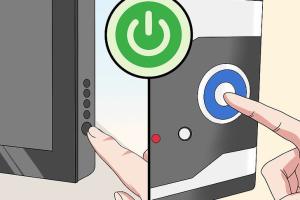Ultimate Guide on How to Open a Computer: Step-by-Step Instructions

-
Quick Links:
- Introduction
- Tools Required
- Safety Precautions
- How to Open a Desktop Computer
- How to Open a Laptop Computer
- Common Issues When Opening a Computer
- Expert Insights
- Case Studies
- Conclusion
- FAQs
Introduction
Opening a computer can seem daunting for many, especially if you're not familiar with hardware. Whether you're looking to upgrade components, clean out dust, or troubleshoot issues, knowing how to open a computer safely is essential. In this guide, we will walk you through the process for both desktop and laptop computers, ensuring you have the knowledge to handle your hardware confidently.Tools Required
Before diving into the process, it’s important to gather the necessary tools. Having the right equipment will not only make the task easier but also safer.- Philips screwdriver
- Flathead screwdriver
- Anti-static wrist strap
- Plastic prying tools (for laptops)
- Flashlight
- Compressed air canister
- Clean cloth
Safety Precautions
Safety should always be your top priority when working with computer hardware. Here are some precautions to keep in mind:- Power Off: Always turn off and unplug your computer before opening it.
- Static Electricity: Use an anti-static wrist strap to prevent damaging components.
- Work Area: Ensure your work area is clean and well-lit to avoid losing small components.
- Handle with Care: Be gentle when handling parts, especially delicate components like RAM and motherboards.
How to Open a Desktop Computer
Opening a desktop computer is generally straightforward. Here’s a step-by-step guide:Step 1: Prepare Your Workspace
Choose a flat, static-free surface. Ensure your tools are within reach.Step 2: Disconnect All Cables
Unplug all peripherals and power cables from the computer.Step 3: Remove the Side Panel
Most desktop cases have screws or thumb screws on the back that secure the side panel. Remove these screws and slide the panel off.Step 4: Ground Yourself
Before touching any internal components, ground yourself using the anti-static wrist strap.Step 5: Access Internal Components
Once the case is open, you can access the internal components like the motherboard, power supply, and storage drives.How to Open a Laptop Computer
Opening a laptop can be more complicated due to its compact design. Follow these steps carefully:Step 1: Power Down and Disconnect
Turn off the laptop and unplug it. Remove the battery if possible.Step 2: Remove Screws
Locate screws on the bottom panel of the laptop. Use a Philips screwdriver to remove them carefully.Step 3: Use a Plastic Pry Tool
Insert the plastic pry tool into the seam of the laptop case and gently work your way around to unclip the panel.Step 4: Lift Off the Panel
Once unhinged, carefully lift off the panel to reveal the internal components.Step 5: Perform Your Maintenance
You can now access components like RAM, hard drive, and cooling fans for upgrades or cleaning.Common Issues When Opening a Computer
Even with the best preparations, issues can arise. Here are some common problems and their solutions:- Stuck Screws: Use penetrating oil to loosen screws that won’t budge.
- Fragile Components: Be extra cautious with connectors and cables; they can break easily.
- Static Damage: If you suspect static damage, consult a professional before proceeding.
Expert Insights
Experts recommend documenting your disassembly process with photos. This will help you remember how to reassemble your computer later. Additionally, following manufacturer guidelines can provide specific instructions tailored to your model.Case Studies
1. **Case Study 1**: A user upgraded their desktop's RAM by following our guide and reported a 50% performance improvement in gaming. 2. **Case Study 2**: A laptop user successfully cleaned their cooling fan, which resolved overheating issues that had plagued their device for months.Conclusion
Knowing how to open a computer is a valuable skill that can save you time and money. With the right tools, safety precautions, and this comprehensive guide, you’re well on your way to becoming a DIY computer technician.FAQs
- Q1: Is it safe to open my computer? A1: Yes, as long as you follow safety precautions, such as grounding yourself and turning off the power.
- Q2: Do I need special tools to open my computer? A2: A basic set of screwdrivers and an anti-static wrist strap are usually sufficient.
- Q3: How often should I open my computer for cleaning? A3: It’s recommended to clean your computer every 6-12 months, depending on dust levels.
- Q4: Can I void my warranty by opening my computer? A4: Some manufacturers may void warranties if tampering is detected; check your warranty terms.
- Q5: What should I do if I can’t put my computer back together? A5: Refer to the photos you took or seek help from a professional technician.
- Q6: How do I know if I’ve damaged a component? A6: If the computer doesn’t power on or shows unusual behavior, you may have damaged components.
- Q7: Is there a difference between opening a PC and a laptop? A7: Yes, laptops are more compact and may require more careful handling due to delicate components.
- Q8: What are the risks of opening a computer? A8: Risks include static damage, physical damage to components, and voiding warranties.
- Q9: Can I upgrade my computer components while it's open? A9: Yes, this is a great opportunity to upgrade RAM, storage, or cooling systems.
- Q10: Where can I find more detailed guides? A10: Websites like iFixit and YouTube have extensive guides and tutorials on computer repair.
Random Reads
- Simple steps change general preferences safari
- How to win any pokemon battle with a level 1 rattata
- Two simple ways to erase and format usb flash drive
- Mastering gmail on iphone
- Mastering google chrome extensions
- Mastering audacity
- Mastering auto numbering in excel
- How to insert pictures in excel
- How to insert images with html
- How to tar a directory linux